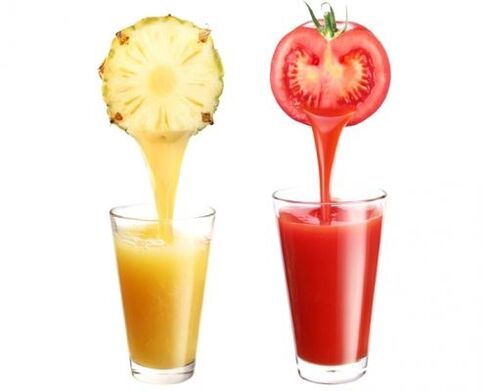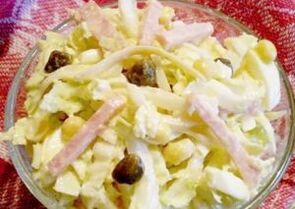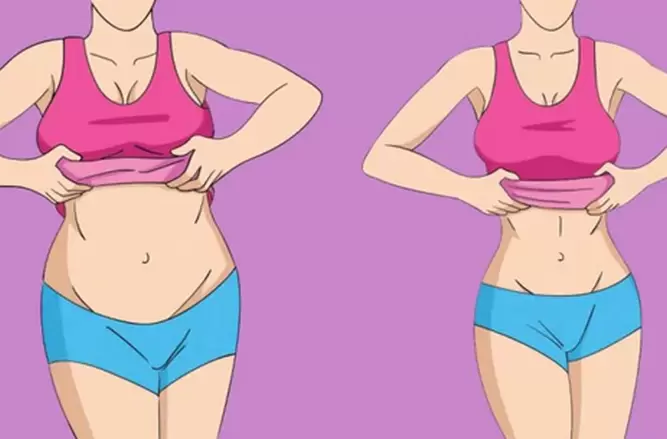The Japanese, or Japanese diet, was developed by nutritionists at YaELO Clinic (Yaeks). The principle of the technique is based on the consumption of low-calorie food for 7-14 days. Before starting a strict diet, experts recommend to prepare mentally - the weight loss system requires strict adherence to all the rules of the method. This excess weight loss system is characterized by a long withdrawal: it lasts 4 weeks. Despite its high effectiveness, diet can harm the body, especially if there are contraindications.

The principle of weight loss
The Japanese diet is for 7, 14 or 13 days. Proper weight loss is done by using foods that are high in protein. Foods high in carbohydrates and fats are not included in the diet. The technique is considered "without salt. " The initial stage of weight loss is accompanied by the normalization of metabolic processes in the body, the removal of toxins. The fat burning process begins in 2-3 days.
It is impossible to deviate from the regime - the diet is strictly set. As meals lack enough carbohydrates, the duration of the diet should not exceed 14 days. The occurrence of side effects requires immediate discontinuation of diet therapy and is a reason to seek medical attention. During weight loss, the consumption of vitamins and minerals is encouraged, the complex is selected individually. It can take up to a month to get out of the diet.
Dietary rules

Dishes made from permitted foods can fill you up quickly. This is because they contain the main "building block" - protein. Carbohydrates and fats enter the body in small amounts. Fiber is found in fresh vegetables and fruits and their use is unrestricted. Soluble dietary fiber helps maintain normal functioning of the digestive system. Antioxidantsinvolved in metabolism are green tea and natural coffee.
A menu specially selected for each day provides the body with the necessary nutrients.
It is necessary to closely monitor the drinking regime: you need to drink at least 1, 5 liters of fluid per day. The presence of salt, sugar and hot spices in the dishes is unacceptable. The number of meals is limited: no more than 3 times a day. You can't have a snack.
Experts recommend giving up sweets and fast food in advance - this will help prevent spoilage. It is recommended to reduce portions.
Permitted and prohibited products
The list of permitted products is strictly limited. The 14-day daily menu can be:
- meat and poultry products;
- fish;
- bread;
- vegetables;
- fruits;
- freshly squeezed natural juices;
- Dairy Products;
- tea and still mineral water.
Vegetables, fruits and greens you can eat:
- zucchini;
- carrots;
- Eggplant;
- cabbage;
- apples;
- pineapples;
- pears;
- stone;
- pomelo;
- citrus fruits (oranges, lemons).
Bread and rusks should be rye. Lean meat (lean beef, chicken, turkey) and fish (hake, blue whiting, cod) are cooked. Eggs are allowed, but in small quantities. Beverages (green tea, natural weak coffee, boiled water) should not contain sweeteners. You can drink tomato juice and low-fat (1%) kefir. Olive oil is included in the diet.
Prohibited foods must be completely excluded from the menu. These include:
- fatty meats and fish;
- vegetable oils;
- salts and sugar;
- fast food;
- flour products;
- smoked and cooked sausages;
- semi-finished and preserved foods;
- sweets and cakes;
- foods containing starch (vegetables, grains);
- alcohol and tobacco products;
- sauces, marinades.
Vegetables and fruits:
- Cherries;
- cherries;
- Pomegranate;
- persimmons;
- mandarins;
- mango;
- figos;
- passion fruit;
- Grape.
Dried fruits:
- plums;
- raisins;
- dried apricots;
- data.
The Japanese rarely eat dairy products because they often do not tolerate lactose, so they are not included in the diet.
It is necessary to exclude potato chips, sweet and cheese popcorn from the diet. Semolina, barley and millet groats are not used to make food that promotes fat burning.
Prohibited flour products:
- pancakes;
- dumplings;
- vareniki;
- spaghetti (pasta);
- pancakes;
- pasta;
- wheat bread;
- buns.

Confectionery (sweets, biscuits, cakes, rolls, pies, marshmallows, halva, canned food, jam) is strictly prohibited. No condiments (spices, mayonnaise, ketchup) are added to the dishes. Any dairy products (cream, cheese, fermented fried milk, skimmed milk, cream) are prohibited.
Meat and sausages:
- pork;
- sheep;
- ham;
- cooked pork;
- Salo;
- smoked sausages;
- uncooked smoked, cooked, dry - dried sausages.
Dried, smoked and dried fish should be removed from the diet immediately. Poultry is used only in cooked form. Do not use chocolate, ghi and butter. Alcoholic beverages and tobacco products are excluded 2-3 weeks before weight loss. Highly carbonated sweet drinks (lemonade, kvass) are replaced with still mineral water.
Dried fruit compotes, jelly are not included in the oral diet. It is also necessary to refrain from cherry, apple, pomegranate, grape and orange juice. Nectars are prepared from pineapples and tomatoes, they are drunk in small quantities.

Types of Japanese diet
There are 3 types of Japanese diets. They differ in the number of days:
- 7 days;
- 13 days;
- 14 days.
The diet should be followed regardless of the type of technique.
Diet for 14 days
Slimming system without salt for 2 weeks. During this period, the fat cells are gradually released and they burn. During the first 3 days the body is cleansed. During this period, experts recommend drinking plenty of fluids: boiled water and green tea speed up the flushing of the remaining toxins. Generally, the diet can be divided into 2 stages, each lasting 7 days. In the first stage, kefir is included in the menu. Dishes are steamed, no attention is paid to baking and stewing.
Diet for 7 days
The mildest technique created for the week. During this period, you can lose no more than 3-4 kilograms. The menu is strict, the products are strictly limited and cannot be changed. During the weight loss period, restructuring takes place, during which the body becomes accustomed to a new diet, which is why experts consider this system to be the least effective. The menu can be traditional Japanese cuisine prepared from permitted ingredients. They cannot be supplemented. For people planning to lose weight, according to Japanese women, nutritionists recommend choosing the "light weight" option.
Diet for 13 days
The principle of operation of this type is no different from the previous two. The portion weight does not exceed 200 g, the liquid is taken in thirst. Food - at the same time for 13 days. All detoxification rules must be followed. In less than 2 weeks, the intestines are completely cleansed, the fat burning process takes place gradually, so the skin retains its elasticity in problem areas. The amount of energy consumed is supplemented by protein foods.
Diet plan per day
The slimming dishes are fully adapted to European cuisine and do not contain exotic ingredients. The approximate menu is created for 7 days, it is repeated on day 8. It is allowed to change drinks: replace coffee with green tea, kefir with tomato juice. The daily rate for the products is, if necessary, divided into 2 parts according to the number of days (with a weekly weight loss).
Diet schedule (14 days):
- chicken fillet - 1 kg;
- fish fillet - 2 kg;
- lean beef - 1 kg;
- crackers or rye bread - 0, 5 kg;
- chicken eggs - 20 pcs. ;
- white cabbage - 2 pcs. ;
- zucchini and / or aubergines - 1 kg;
- carrots - 2, 5-3 kg;
- fruit (unsweetened) - 1 kg;
- lemons (large) - 2 pcs. ;
- kefir (low fat) - 1 l;
- olive oil - (cold pressed) - 0, 5 l;
- tomato juice (homemade) - 1 liter;
- natural coffee (cereals or powder) - 1 pack;
- green (large leaf) tea - 1 pack.
The rate of water consumption depends on a person’s age and weight.
The food set is enough for three meals a day. Carbonated mineral water can be replaced by boiled water. The minimum amount of fluid per day is 1, 5 liters.
Detailed daily menu plan (by day):
- For breakfast (8. 00) - a cup of weak natural coffee. Do not add cream, sugar, condensed milk. For lunch (13. 00) - finely chopped cabbage, stewed in its own juice, adding a small amount of olive oil, 2 hard-boiled eggs and 250 ml of tomato juice. For dinner (18. 00) - fish (200 g boneless fillet), stewed or boiled.
- Breakfast - coffee without milk and sugar, a slice of rye bread. Lunch - cabbage stewed in olive oil and steamed (boiled) fish fillet (100 g). Dinner - boiled beef pulp (100 g) and 250 ml of low-fat kefir.
- For breakfast - a cup of weak natural coffee and rye croutons. For lunch - a vegetable stew made of eggplant or zucchini. For dinner, a salad of fresh white cabbage seasoned with oil. You can eat 2 eggs and 200 g of boiled lean beef (pulp).
- Breakfast - green mashed carrots, lemon juice. Lunch - cooked boneless fish fillet (200 g), 250 ml of tomato juice. Dinner - unlimited fruit.
- For breakfast - green mashed carrots, lemon juice. For lunch - cooked boneless fish fillet (200 g), a glass of tomato juice. For dinner - fruit in any quantity.
- Breakfast - coffee or green tea without sugar. Lunch - 0, 50 boiled chicken (breast or thighs without skin), fresh vegetable salad (carrots and cabbage) with a little oil. Dinner - boiled chicken eggs (2 pcs. ), Salad of fresh grated carrots with butter.
- For breakfast - green tea without sugar. For lunch - stewed or boiled beef pulp. For dinner - any meal (except dinner for 3 nights).
The menu can be displayed schematically. Experts recommend placing a sheet with a drawing in a visible place.
The right way out of the diet
A certain diet should be followed for 2-4 weeks after the diet. During weight loss, the body gets used to small portions and low-calorie foods. In order to maintain a normal weight and optimal functioning of the gastrointestinal tract, it is necessary to abandon the diet. It is recommended to return to a normal diet gradually: foods rich in carbohydrates are added little by little every day. The duration of the release is at least 14 days.
Food should be partial, portion weight should not be increased. The diet should be dominated by foods that are low in calories and supplement the energy stored during slimming. Reducing protein intake (chicken eggs, poultry and fish) is not recommended. Fats and carbohydrates in the menu are introduced gradually. Salt and sugar can be added in small doses. The drink should be plentiful, consume no more than 2 liters per day.
When leaving the diet, breakfast is allowed to eat cereals. Oatmeal, buckwheat and rice groats boiled in water. Vegetables and fruits are eaten raw in any quantity. It is best to give preference to sweet and sour apple varieties. The main meals include snacks: a glass of kefir or rice cakes. Rye bread is replaced by whole grain or yeast-free bread.
Pasta and pastries, pastries and snacks are not included in the diet.
The price of diet
Products approved for use in weight loss are medium price categories.
Pros and cons
The Japanese weight loss technique has many advantages and disadvantages. Advantages:
- efficiency;
- availability;
- cleaning combined with weight loss;
- comprehensive menu;
- Three meals a day;
- increased muscle tone.
The efficiency is due to the fast fat burning process, the result appears after 7 days. The products are available to everyone and can be purchased at any store. No need to pre-calculate calories, the menu is clearly written. Food is consumed 3 times a day, the diet is saturated, so the feeling of hunger rarely occurs. Body cleansing helps to normalize metabolic processes. High protein content strengthens muscle structure.
The disadvantages are:
- unbalanced diet;
- vitamin and mineral deficiency;
- lack of a rich breakfast;
- the need to follow dietary discontinuation rules;
- short-term weight loss;
- contraindications.
An unbalanced diet and a lack of fat, protein, and carbohydrate ratio increase the risk of side effects. Decreased natural defenses, deterioration of nails and hair are caused by a lack of vitamins in the body. The right way out of the diet prevents the development of stressful situations that can lead to rapid weight gain.
Contraindications and harm

The diet is only suitable for healthy people. Before losing weight, you should take an exam and consult a nutritionist. Contraindications include:
- pregnancy at any time;
- Breast feeding;
- gastric and duodenal ulcers;
- erosive damage to the digestive system;
- renal and hepatic pathology, including failure;
- anemia;
- gallbladder disease;
- diseases of infectious etiology;
- cardiovascular pathology;
- hypovitaminosis;
- diabetes;
- high blood pressure;
- exacerbation of chronic diseases;
- gout.
The diet is not suitable for the elderly and adolescents. Any non-compliance with the general technical rules increases the risk of side effects. Nausea and faecal disturbances (constipation or diarrhea) may occur in the first few days. Indigestion is accompanied by profuse bloating or colic. Bad breath, heartburn and belching occur. Headaches result from the complete abandonment of sugar.
Neurosis and sleep disorders develop for the same reason. Lack of fat in the mouth results in a bitter taste. The appearance may deteriorate: the skin becomes pale and dry. Lack of nutrients results in joint pain.
Diet recipes
Dietary dishes are included in the menu. You can diversify your diet with salads, first and second courses. Self-made desserts with low sugar content improve brain function and can be consumed after 14-15 days.

Diet salad "Hope" includes the following ingredients:
- potatoes - (2 pcs. );
- milk sausages - (2 pcs. );
- chicken breast - (250 g);
- pickles - (1 pc. );
- greens;
- salt;
- olive oil - (1 tbsp).
Cut the boiled potatoes, boiled chicken and sausages into cubes. Put the mass in a deep bowl and season with salt. Put the sliced cucumber and finely chopped greens there.
Season the salad with olive oil (first pressing).
Cabbage salad:

- Peking cabbage - (250 g);
- fresh cucumbers and tomatoes - (250 g);
- chili peppers - (1 pc. );
- hard cheese - (150 g);
- salt;
- olives (1/2 cans);
- olive oil.
Tear the Chinese cabbage leaves by hand into small pieces. Cucumbers and tomatoes are cut into large pieces. Chop (half the vegetables) in a blender. Mix all the ingredients, salt and season with oil. Garnish the salad with grated cheese and olives on top.
The first courses are eaten at lunch. To make it easier to digest, the soups are prepared refined. Spinach and celery soup:

- lemon - (1 pc. );
- tomatoes - (2 pcs. );
- spinach - (200 g);
- celery - (stem, 2 pcs. );
- greens;
- vegetable broth - (1, 5 l);
- salt;
- olive oil - (1 tbsp. l. ).
Pour the olive oil into the heated pan. Finely chop the celery stalk and fry in oil. In a separate pot, bring the broth to a boil, add the chopped spinach and simmer for 5-7 minutes. Remove the skin from the tomatoes and mash in a grater. Add the tomato paste to the spinach. Salt the broth, add to it for frying. Cook for 15-20 minutes. Add a little lemon juice and chopped herbs to the finished soup.
Creamy mushroom soup:
- champignons - (8 pcs. );
- potatoes - (2 pcs. );
- zucchini - (300 g);
- carrots - (1 pc. );
- onions - (1 pc. );
- weak meat broth - (1 l);
- flour - (1 tbsp. l. );
- olive oil - (2 tbsp. l);
- cream - (1 tbsp. l. ).
Cut the cooked vegetables into small cubes and chop in a grater. Bring the broth to a boil. Bake the flour until golden brown, pour into the broth, there add the vegetable puree. Simmer the soup over low heat until thickened, then salt, add the cream and garnish with herbs. The first dish is served with rye toast.
Beef stew with vegetables:

- beef - (500 g);
- olive oil - (3 tbsp. l. );
- potatoes - (200 g);
- carrots - (1 pc. );
- hot peppers - (1 pc. );
- onions - (1 pc. ).
Sprinkle onions, peppers and grated carrots in olive oil in half rings. Cook the beef until half cooked, cool and cut into small pieces. Put the meat on the fried vegetables, salt. Place the striped potatoes on top. Salt again. Pour the meat broth over the vegetables. Cook the dish on low heat for 25-30 minutes.
Indian manti is a dietary dish that is prepared in two stages. Ingredients for dough:
- flour - (1, 5 glasses);
- warm water - 1 glass;
- salts.
Dissolve the salt in warm water. Pour flour on the work surface, make a recess. Pour salted water in portions, gradually kneading the elastic dough. Cover with a towel and leave for 15-20 minutes.
While the dough is "fit, " you need to prepare the sauce. Required components:
- champignons - (6-8 pcs. );
- carrots - (1 pc. );
- green onions - (4-5 feathers);
- zucchini - (400 g);
- olive oil - (2 tbsp. l);
- tomato paste - (2 tbsp. l. );
- chicken fillet - (400 g).
Cut the mushrooms, zucchini and carrots into small cubes. Boil the chicken fillet and cut into strips. Fry onions in oil and tomato paste, gradually adding carrots, zucchini, mushrooms and meat. Pour 150-200 ml of water into the pan and simmer the vegetables until soft.
Roll out the dough into thin strips and grease each one with oil. Cut the strips into squares (10x10 cm) stacked on top of each other. Steam the dough in a pressure cooker or slow cooker for 15-20 minutes. The "columns" of the dough are placed on a dish, topped with vegetable sauce and sprinkled with herbs.
Results and reviews
You can lose 8-9 kg in 2 weeks. Most women and men who have lost weight using this technique speak positively about it.
First review, woman, 36 years old

I started recovering as a teenager, tried a lot of diets - they didn’t help. I went to a nutritionist, had a medical examination, ate separately, counted calories regularly, prepared fasting days and was able to lose only 2 pounds in 5 months. The Japanese fat burning system was advised by a friend, I failed to lose 7 kg in 2 weeks. I decided to give it a try.
No contraindications were identified after medical examination. The nutritionist provided detailed dietary recommendations. The system does not require large material investments. On the advice of doctors, she drew the menu in detail and attached the sheet to the fridge. I almost lost in the first 3 days: the portions seemed small, the feeling of hunger constantly. Day 4 was easier, I tried chewing longer and drinking more fluids.
The second stage of weight loss quickly passed. I cooked in a machine: I remembered the ingredients in the dishes and their weight. The food began to look satisfied, the hunger practically gone. There were no side effects other than a transient headache on day 3. The nutritionist explained that this is due to a lack of sugar. I left the diet for 20 days. I liked the food at the exit, so I completely gave up on sweet, fatty, salty and smoked food. I am satisfied with the result: I lost 10, 5 kg in 2 weeks. Six months later, I will be using this weight loss system again.
Second review, woman, 28 m
I learned about the technique 2 years ago. At that time, it weighed 107 kg and increased by 164, a figure that is critical. There were health problems and I wasn’t happy with the look. Her friends could not advise an effective diet, so she decided to consult a specialist. The doctor recommended trying to lose weight using the Japanese weight loss system. The long list of groceries was initially frightening, but the nutritionist calmed down and explained the diet in detail.
5 kg was needed for 7 days. The dishes from the menu are hearty, I ate one serving. Initially, there was mild dizziness and mild intestinal upset. The side effects disappeared on their own. She started eating at the same time. The second stage of weight loss was easy: improved lightness, improved appearance and overall well-being. Thanks to the diet, I quit smoking and completely gave up alcohol. 13 kg was lost at the time of release. For 1, 5 years I ate correctly, bathed and ran, the previous weight did not return.
















































































